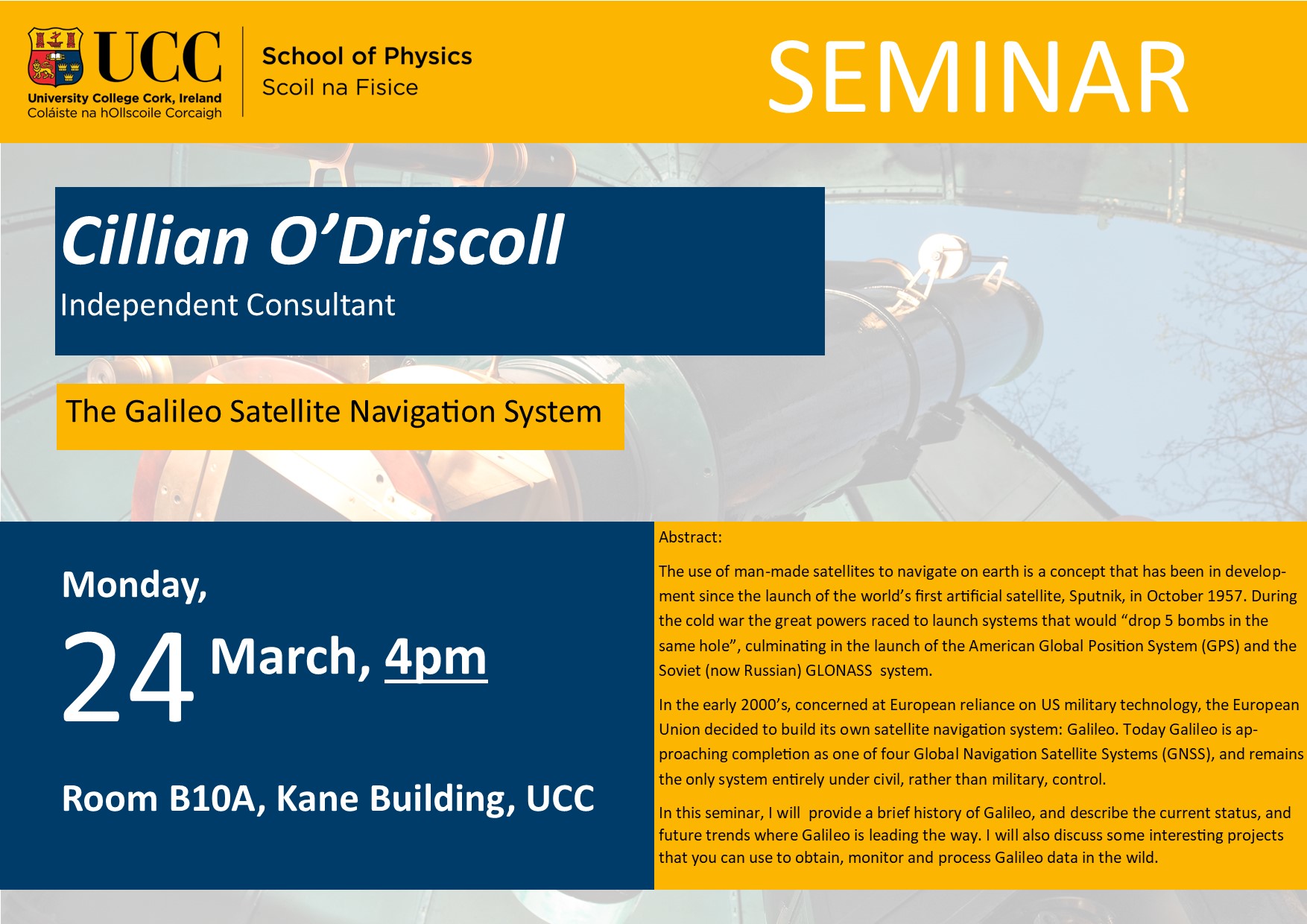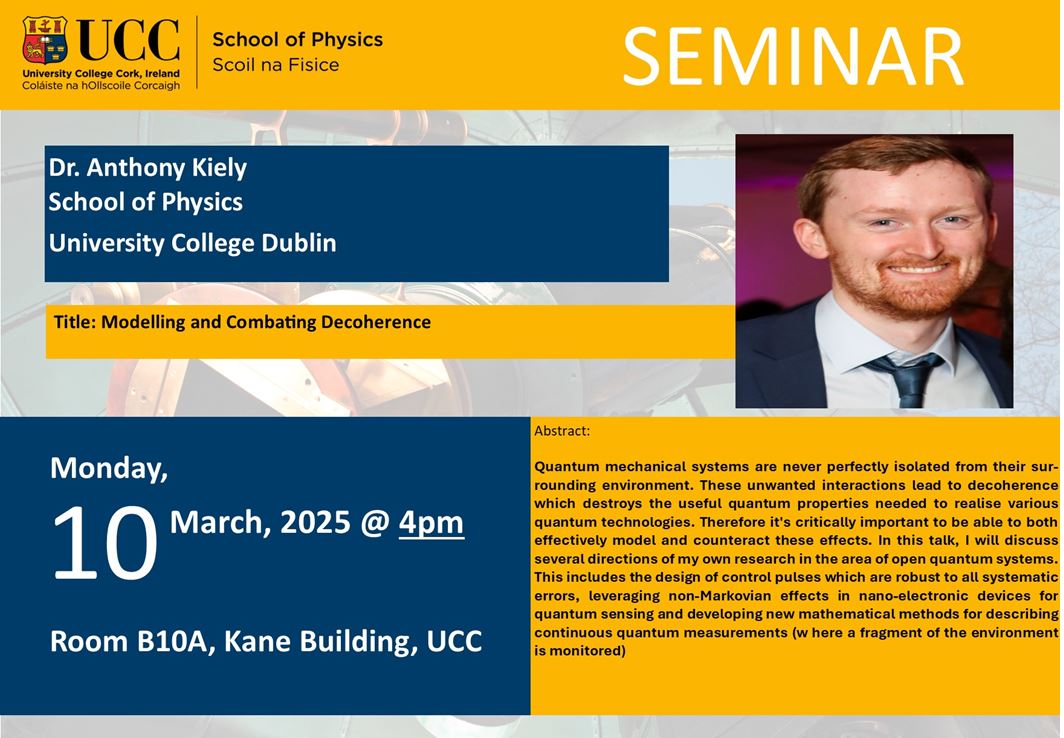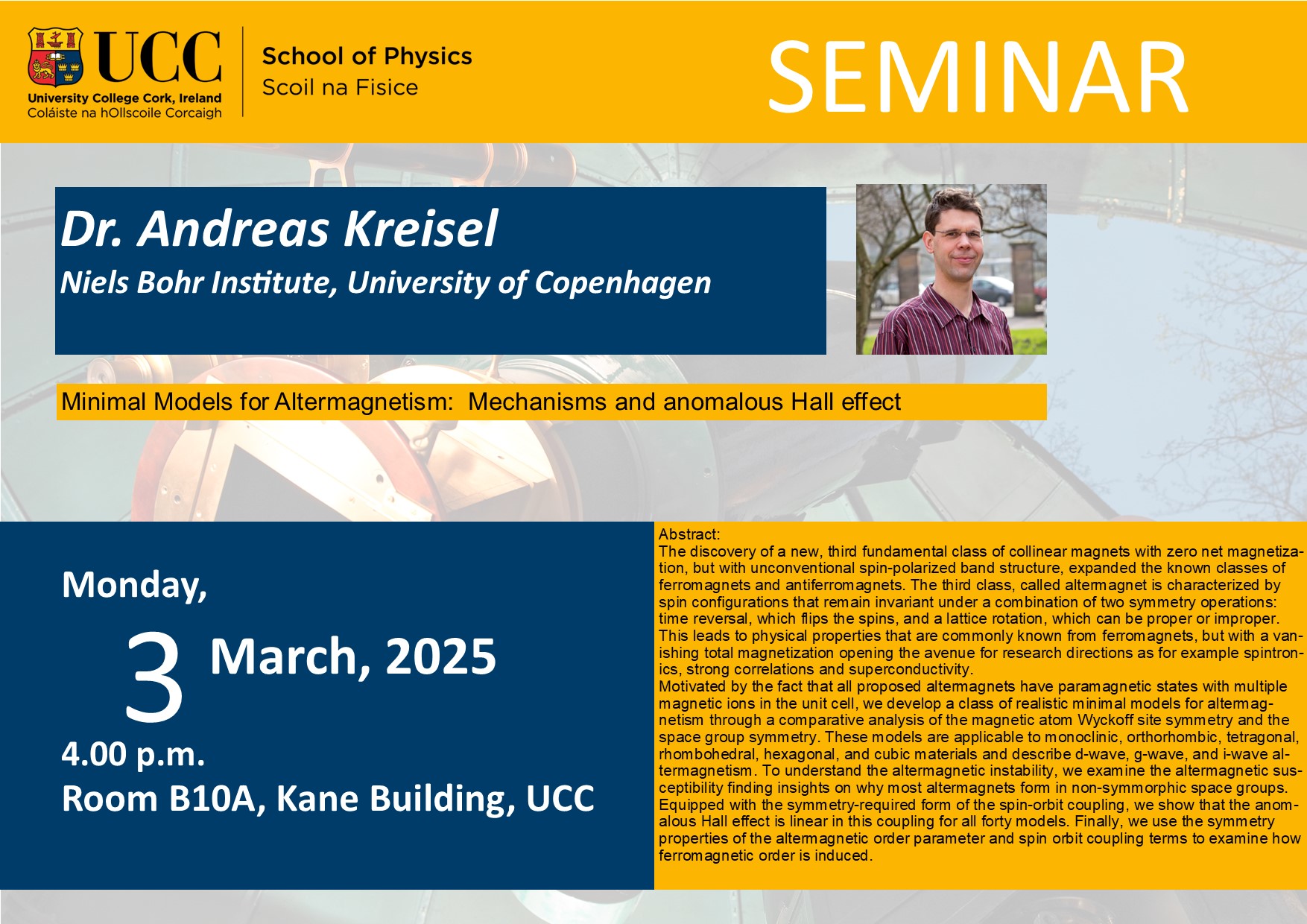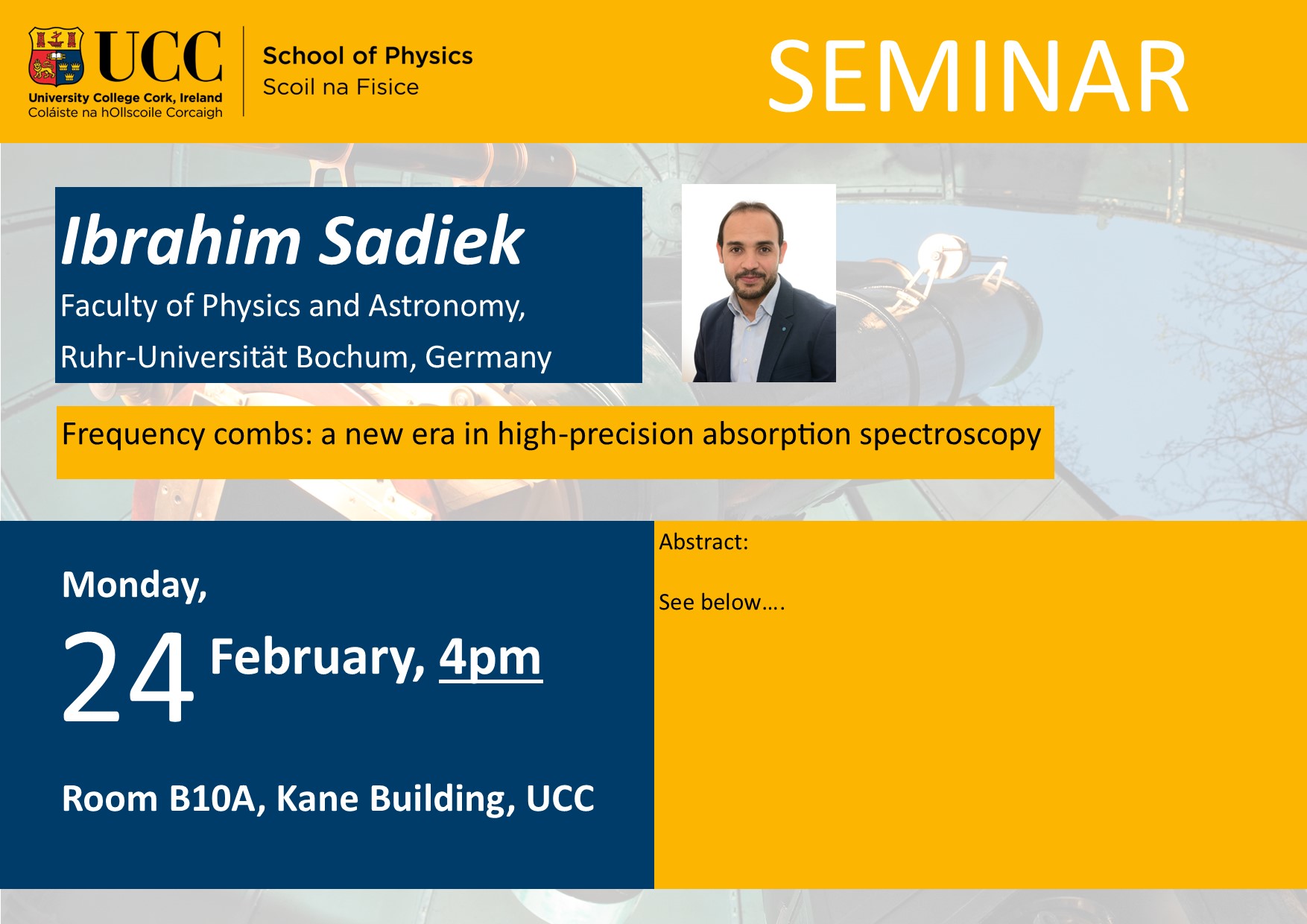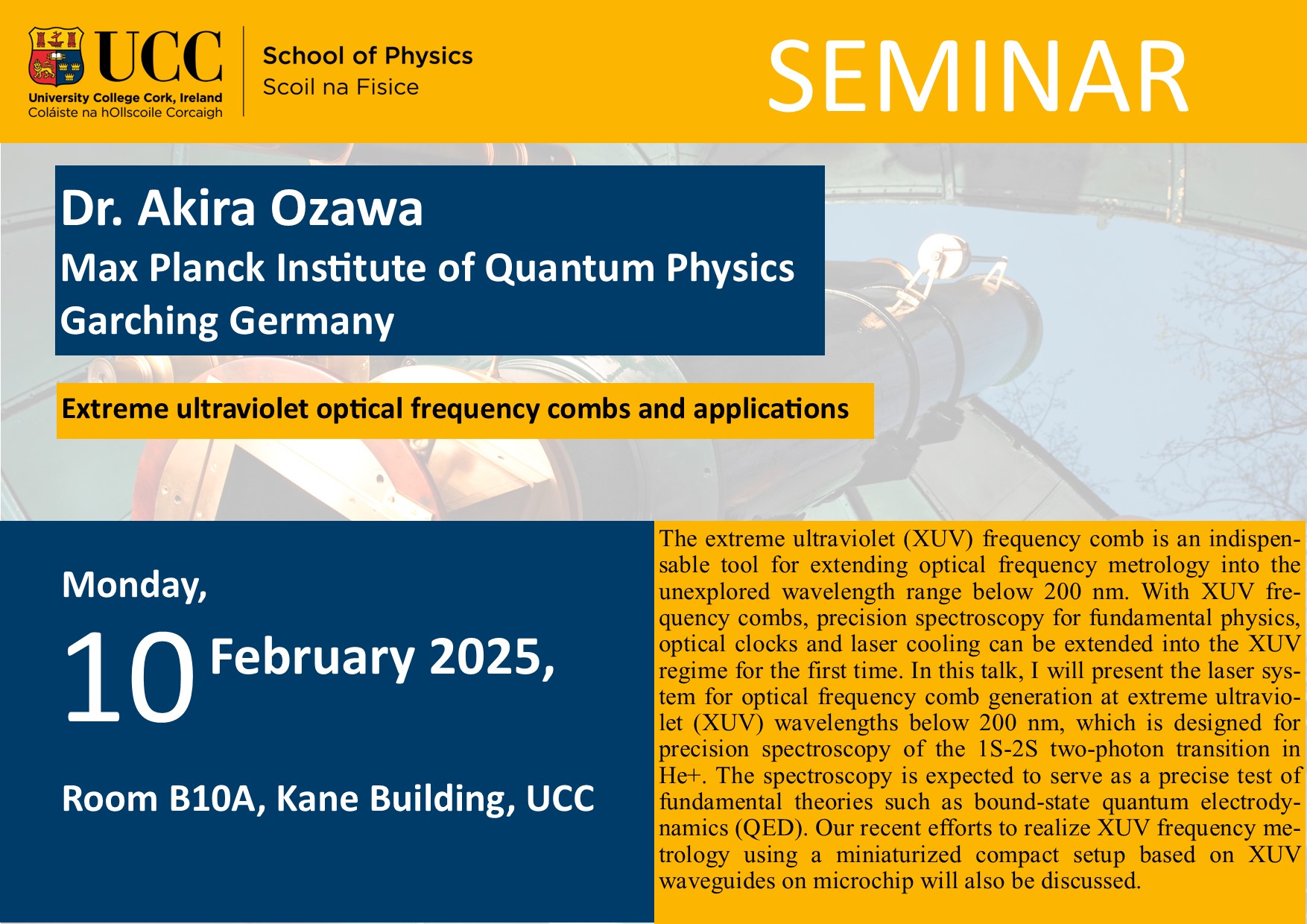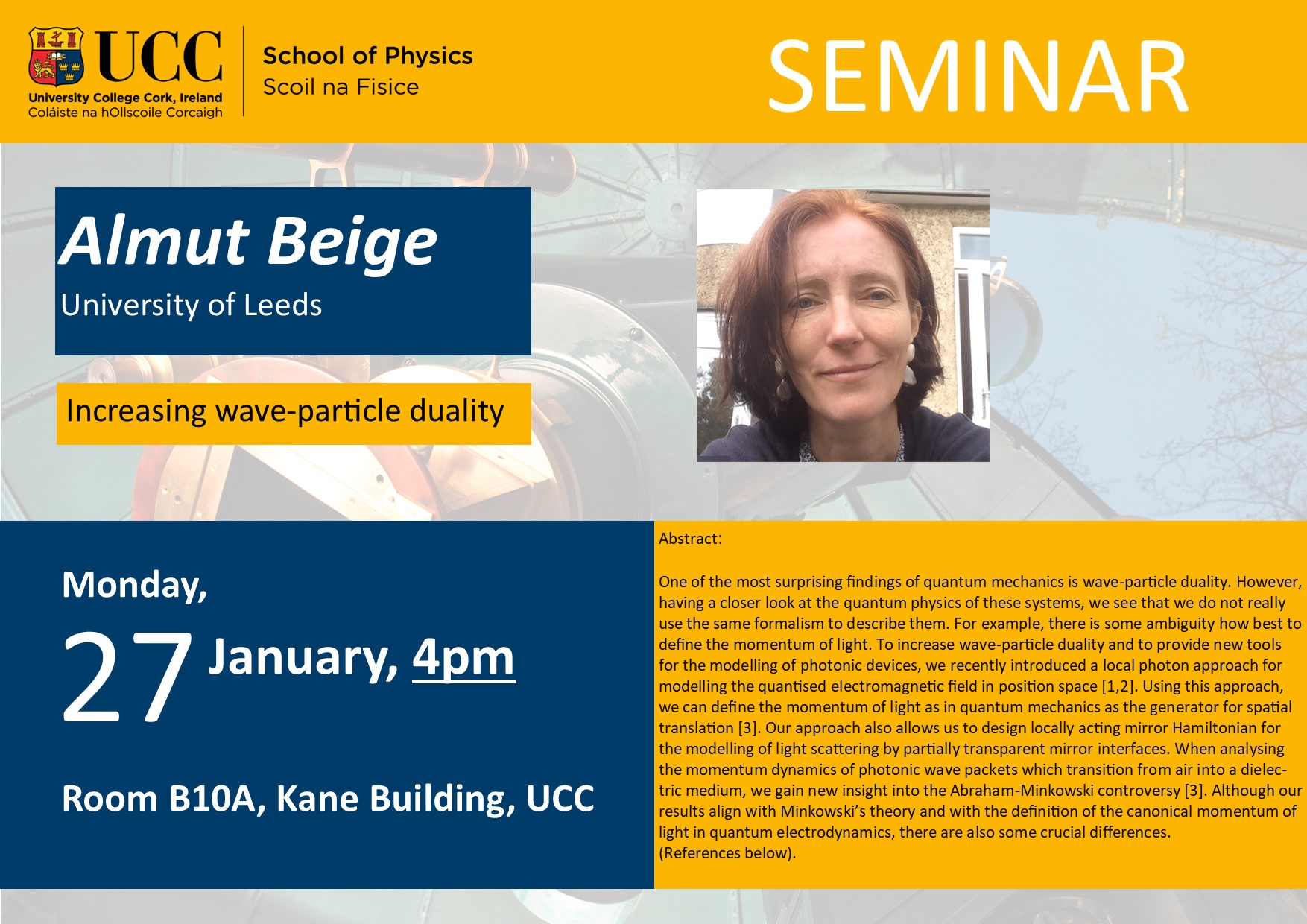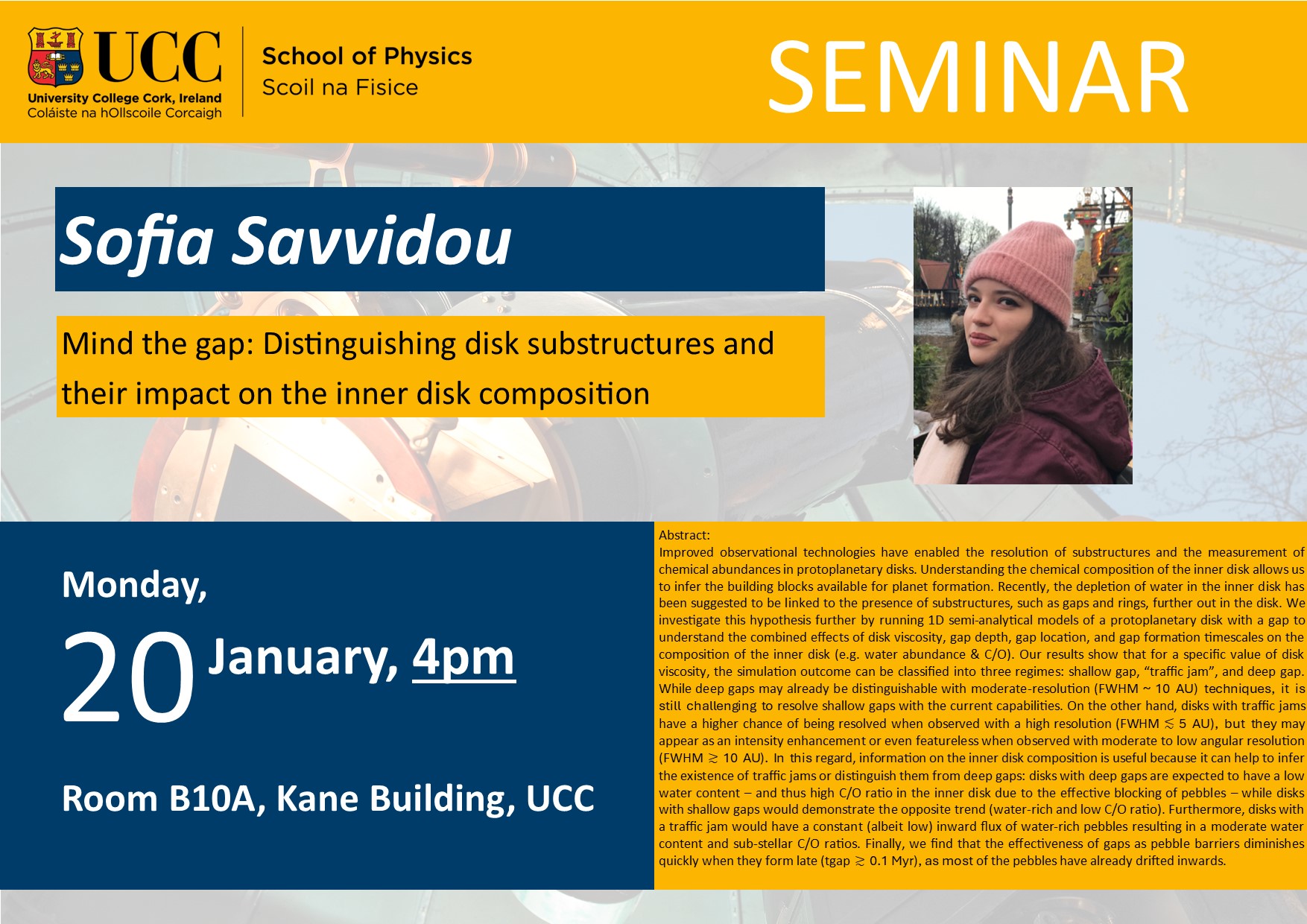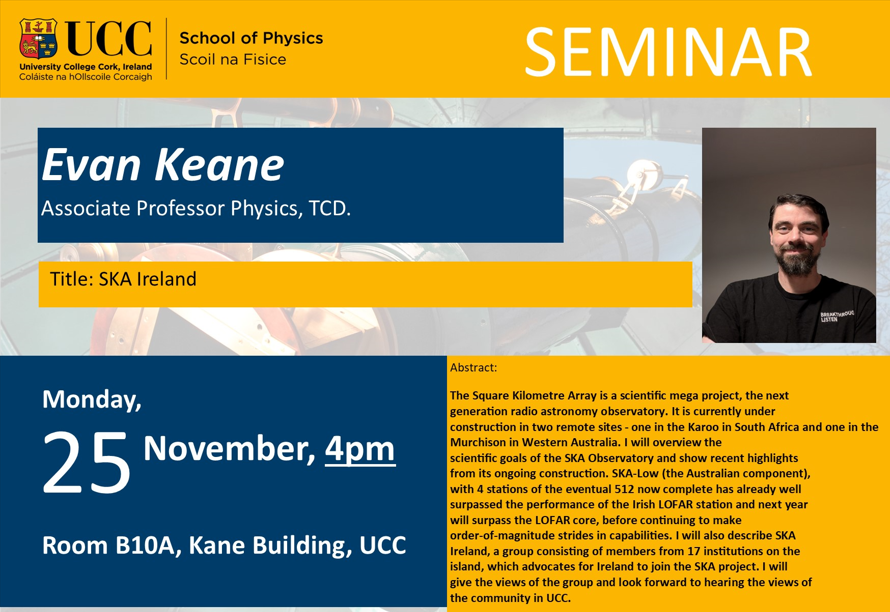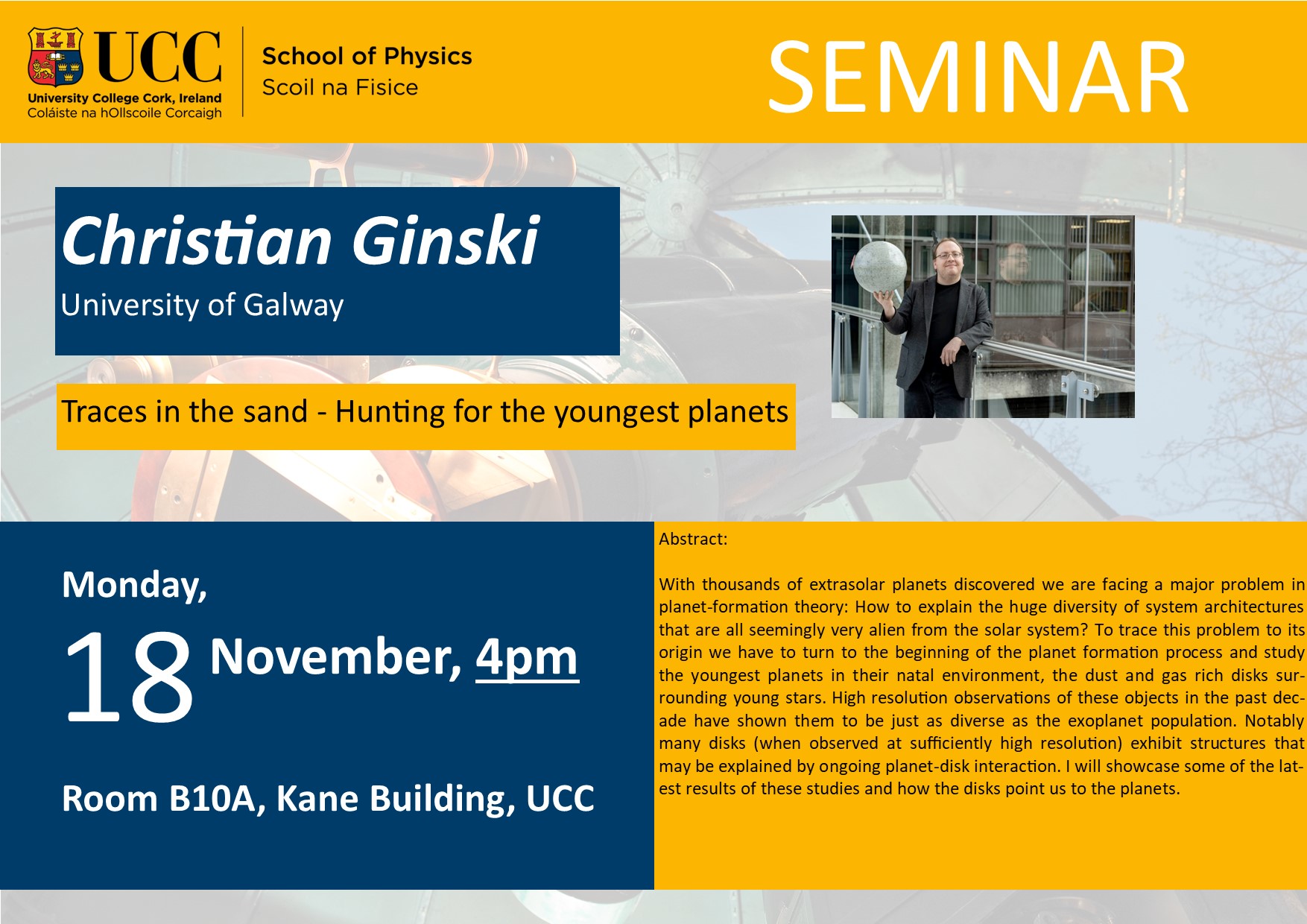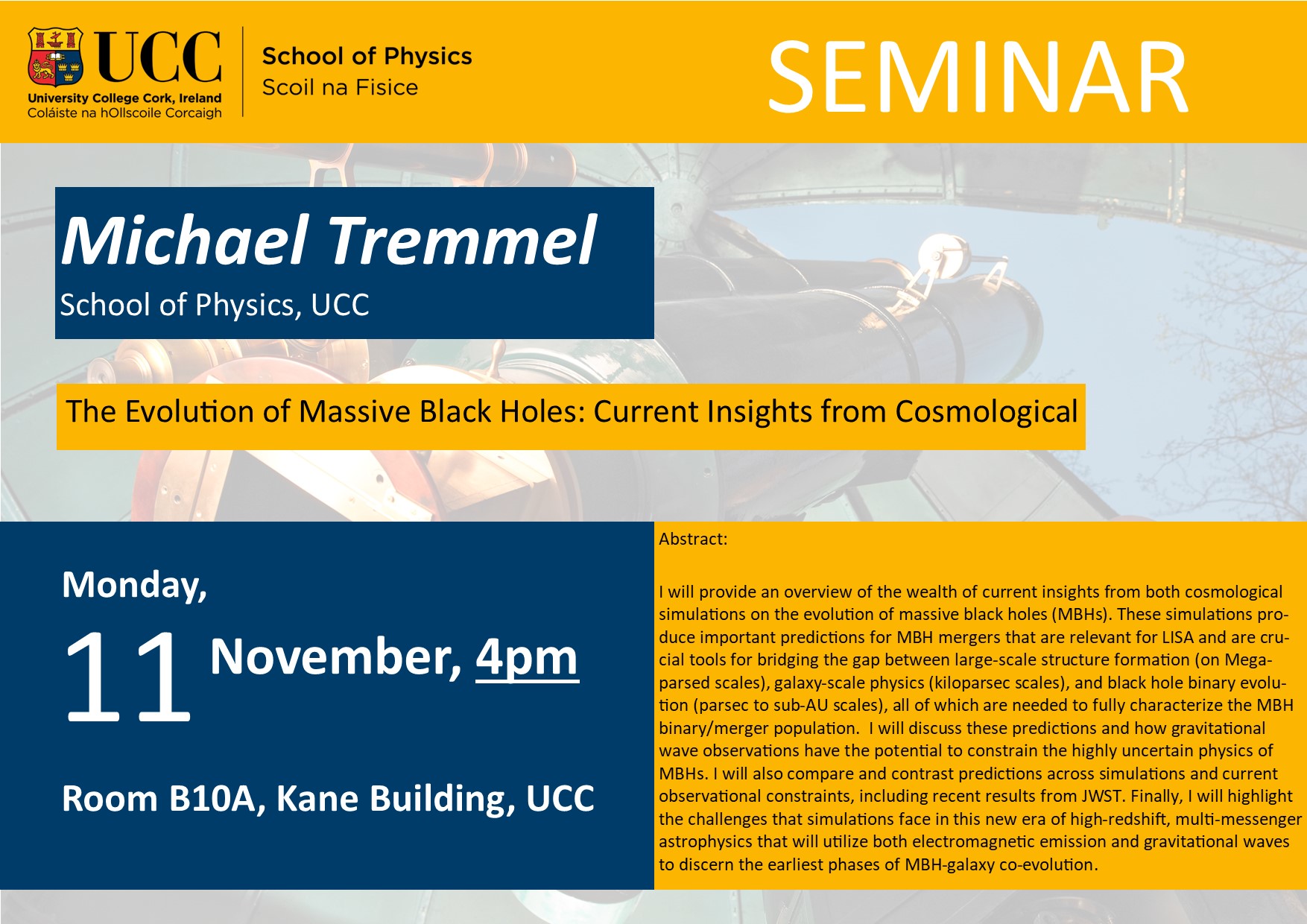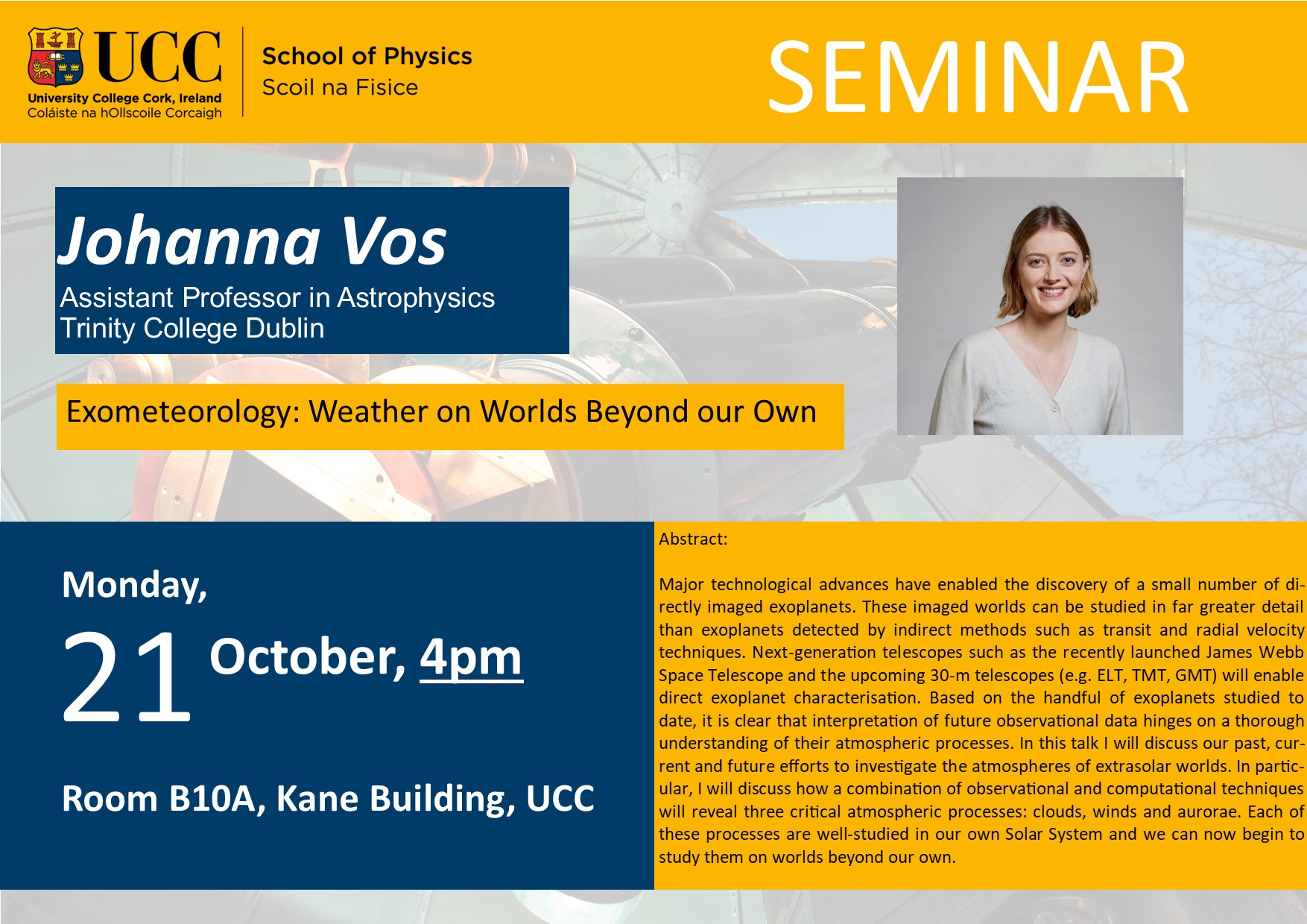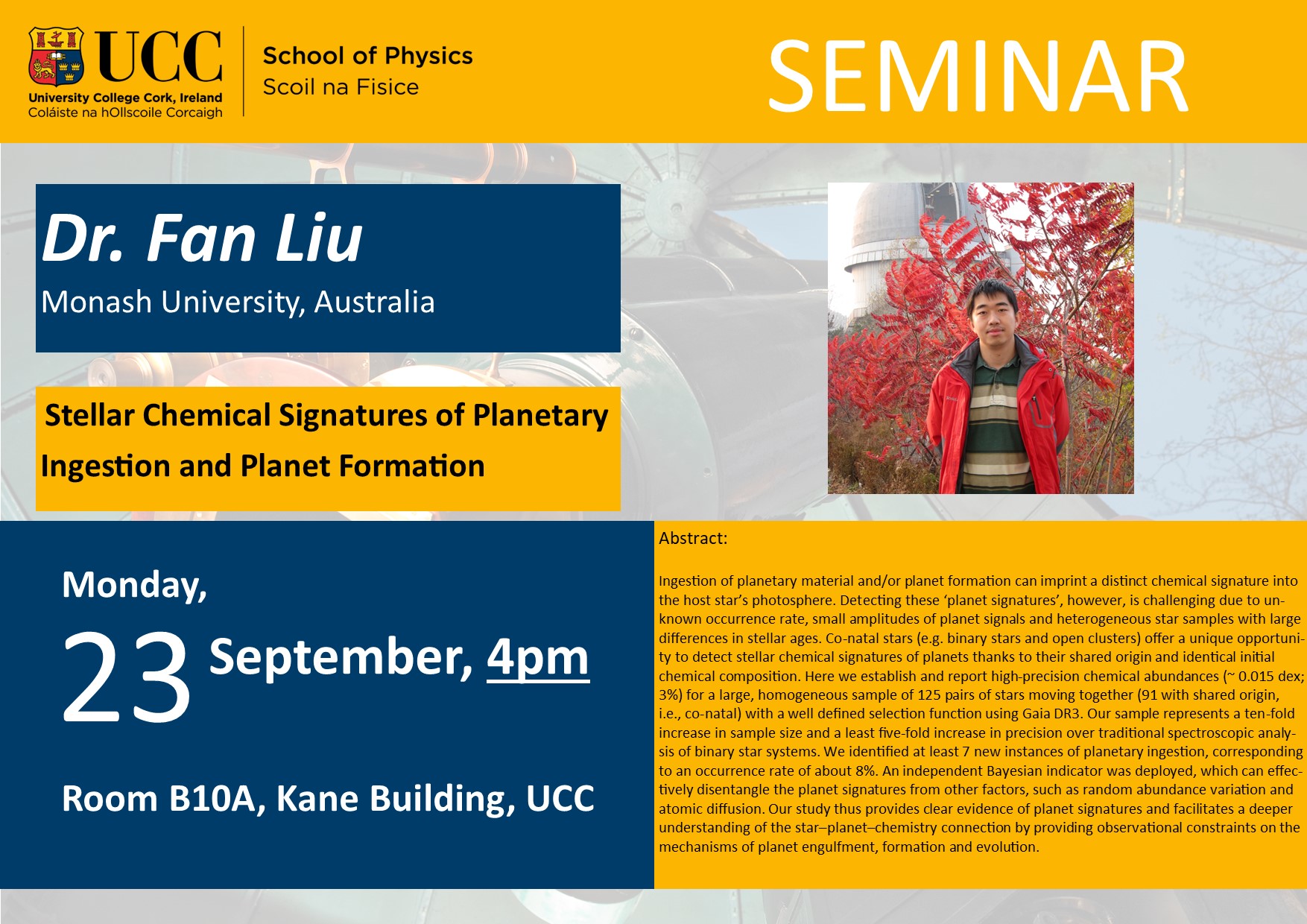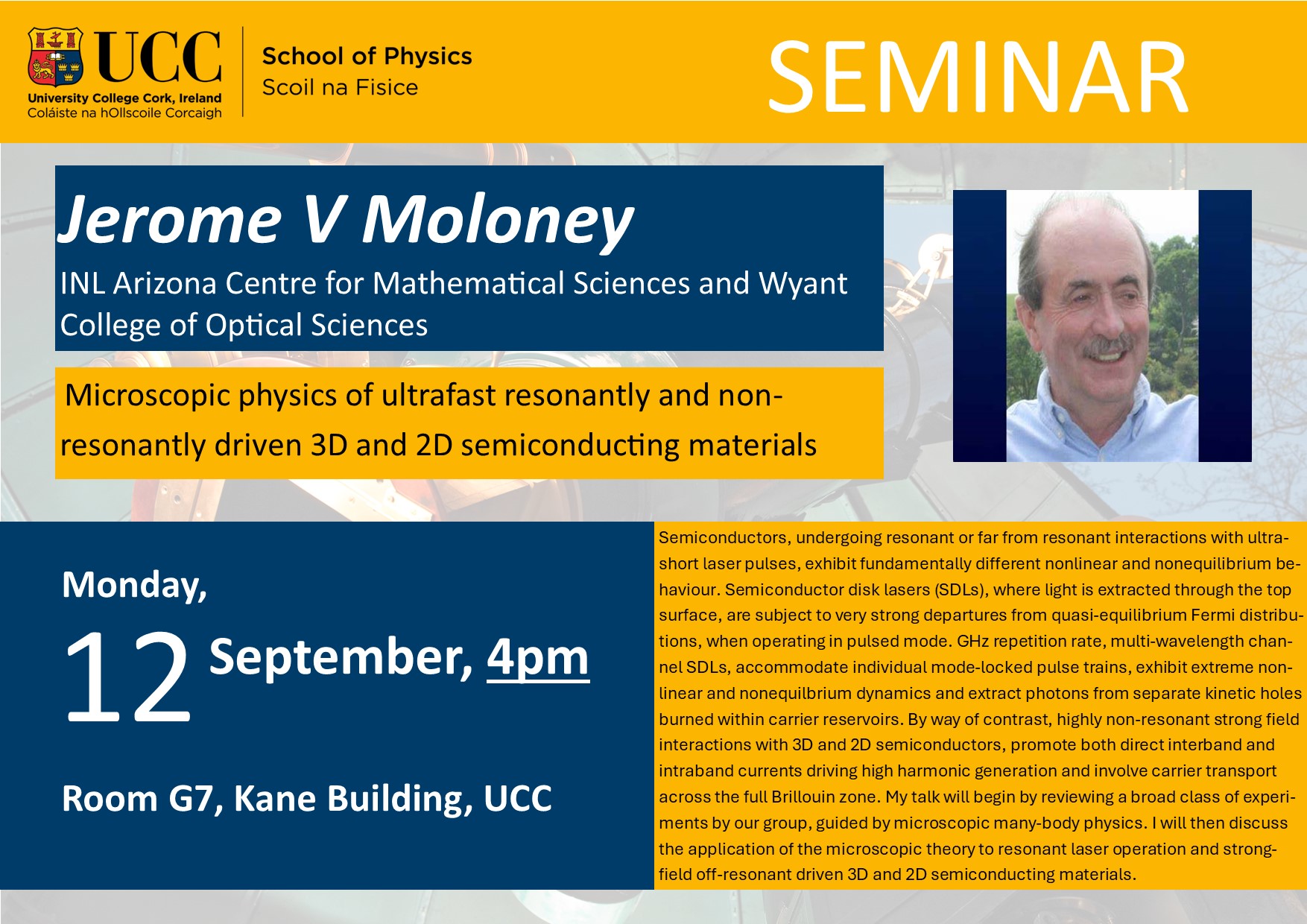- Home
- Semester and Timetable Information
- Study Physics
- Our Research
- Our People
- Careers and Alumni
- Seminars, News and Events
- Outreach and School Resources
- About the School
- What is Physics
- The Crawford Observatory
- Frequently Asked Questions
- UCC Futures Quantum & Photonics
- Supports
Seminars 2024/2025
Cillian O'Driscoll 24 Feb 2025
| Seminar Speaker |
Cillian O'Driscoll
Cillian O’Driscoll holds a PhD in Electrical and Electronic Engineering from UCC. He has been active in satellite navigation research and development since 2001, with more than 70 publications in international conferences and journals. He previously worked as a research engineer in the University of Calgary, Canada, and with the European Commission contributing to the EU satellite navigation system Galileo. He is currently an independent consultant, working with both the European Commission and private sector companies. |
| Venue |
B10A, Basement of Kane Science Building, UCC |
| Time/Date |
4pm / Monday, 24 March, 2025 |
| Title |
The Galileo Satellite Navigation System |
| Abstract |
The use of man-made satellites to navigate on earth is a concept that has been in development since the launch of the world’s first artificial satellite, Sputnik, in October 1957. During the cold war the great powers raced to launch systems that would “drop 5 bombs in the same hole”, culminating in the launch of the American Global Position System (GPS) and the Soviet (now Russian) GLONASS system. In the early 2000’s, concerned at European reliance on US military technology, the European Union decided to build its own satellite navigation system: Galileo. Today Galileo is approaching completion as one of four Global Navigation Satellite Systems (GNSS), and remains the only system entirely under civil, rather than military, control. In this seminar, I will provide a brief history of Galileo, and describe the current status, and future trends where Galileo is leading the way. I will also discuss some interesting projects that you can use to obtain, monitor and process Galileo data in the wild. |
Anthony Kiely 10 March
| Seminar Speaker |
Anthony Kiely |
| Venue |
B10A, Basement of Kane Science Building, UCC |
| Time/Date |
4pm / Monday, 10 March, 2025 |
| Title |
Modelling and Combating Decoherence |
| Abstract |
Quantum mechanical systems are never perfectly isolated from their surrounding environment. These unwanted interactions lead to decoherence which destroys the useful quantum properties needed to realise various quantum technologies. Therefore it's critically important to be able to both effectively model and counteract these effects. In this talk, I will discuss several directions of my own research in the area of open quantum systems. This includes the design of control pulses which are robust to all systematic errors, leveraging non-Markovian effects in nano-electronic devices for quantum sensing and developing new mathematical methods for describing continuous quantum measurements (where a fragment of the environment is monitored). |
Andreas Kreisel 3 March
| Seminar Speaker |
Andreas Kreisel |
| Venue |
B10A, Basement of Kane Science Building, UCC |
| Time/Date |
4pm / Monday, 3 March, 2025 |
| Title |
Minimal Models for Altermagnetism: Mechanisms and anomalous Hall effect |
| Abstract |
The discovery of a new, third fundamental class of collinear magnets with zero net magnetization, but with unconventional spin-polarized band structure, expanded the known classes of ferromagnets and antiferromagnets. The third class, called altermagnet is characterized by spin configurations that remain invariant under a combination of two symmetry operations: time reversal, which flips the spins, and a lattice rotation, which can be proper or improper [1]. This leads to physical properties that are commonly known from ferromagnets, but with a vanishing total magnetization opening the avenue for research directions as for example spintronics, strong correlations and superconductivity[2]. Motivated by the fact that all proposed altermagnets have paramagnetic states with multiple magnetic ions in the unit cell, we develop a class of realistic minimal models for altermagnetism through a comparative analysis of the magnetic atom Wyckoff site symmetry and the space group symmetry. These models are applicable to monoclinic, orthorhombic, tetragonal, rhombohedral, hexagonal, and cubic materials and describe d-wave, g-wave, and i-wave altermagnetism. To understand the altermagnetic instability, we examine the altermagnetic susceptibility finding insights on why most altermagnets form in non-symmorphic space groups. [3] Equipped with the symmetry-required form of the spin-orbit coupling, we show that the anomalous Hall effect is linear in this coupling for all forty models. Finally, we use the symmetry properties of the altermagnetic order parameter and spin orbit coupling terms to examine how ferromagnetic order is induced [4].
[1] Libor Šmejkal, Jairo Sinova, and Tomas Jungwirth, Phys. Rev. X 12, 031042 (2022) [2] Libor Šmejkal, Jairo Sinova, and Tomas Jungwirth, Phys. Rev. X 12, 040501 (2022) [3] Mercè Roig, Andreas Kreisel, Yue Yu, Brian M. Andersen, Daniel F. Agterberg, Phys. Rev. B 110, 144412 (2024) [4] Mercè Roig, Yue Yu, Rune C. Ekman, Andreas Kreisel, Brian M. Andersen, Daniel F. Agterberg, arXiv:2412.09338 (2024) |
Ibrahim Sadiek 24 Feb 2025
| Seminar Speaker |
Ibrahim Sadiek |
| Venue |
B10A, Basement of Kane Science Building, UCC |
| Time/Date |
4pm / Monday, 24 Feb, 2025 |
| Title |
Frequency combs: a new era in high-precision absorption spectroscopy |
| Abstract |
The advent of optical frequency combs has ushered in a new era in molecular absorption spectroscopy, providing an unmatched combination of broad spectral bandwidth and high spectral resolution. Frequency combs are produced by stabilized femtosecond lasers that emit short, regular pulses of light. The spectrum of these lasers in the frequency domain is very broad and consists of hundreds of thousands of narrow, equidistant lines rather than a continuous spectrum as in thermal sources. As technology progresses, frequency combs will continue to transform spectroscopy, driving advances in fundamental laboratory research, industrial applications, and environmental monitoring. I will introduce two optical frequency comb-based methods that enable high-precision measurements of individual comb lines: (i) Fourier transform spectroscopy and (ii) virtually imaged phased array spectroscopy (based on optical dispersion). The latter, achieves record spectral resolution that is not limited by the intrinsic resolution of the dispersive elements. I will present two key applications of these methods that fully exploit the spectral resolution and bandwidth of frequency combs in the mid-infrared region: (1) providing line lists and developing spectroscopic models for halogenated volatile organic compounds (e.g., CH3I and CH2Br2), essential for atmospheric monitoring and astrophysics, and (2) analysing complex spectra of multiple plasmas-generated species (e.g., CH4, C2H2, C2H6, HCN, HNC, NH3), where quantum state populations deviate from the thermal Boltzmann distribution.
|
Akira Ozawa 10 Feb 2025
| Seminar Speaker |
Akira Ozawa |
| Venue |
B10A, Basement of Kane Science Building, UCC |
| Time/Date |
4pm / Monday, 10 Feb, 2025 |
| Title |
“Extreme ultraviolet optical frequency combs and applications” |
| Abstract |
The extreme ultraviolet (XUV) frequency comb is an indispensable tool for extending optical frequency metrology into the unexplored wavelength range below 200 nm. With XUV frequency combs, precision spectroscopy for fundamental physics, optical clocks and laser cooling can be extended into the XUV regime for the first time. In this talk, I will present the laser system for optical frequency comb generation at extreme ultraviolet (XUV) wavelengths below 200 nm, which is designed for precision spectroscopy of the 1S-2S two-photon transition in He+. The spectroscopy is expected to serve as a precise test of fundamental theories such as bound-state quantum electrodynamics (QED). Our recent efforts to realize XUV frequency metrology using a miniaturized compact setup based on XUV waveguides on microchip will also be discussed.
|
Almut Beige 27 Jan 2025
| Seminar Speaker |
Dr Almut Beige |
| Venue |
B10A, Basement of Kane Science Building, UCC |
| Time/Date |
4pm / Monday, 27 Jan, 2025 |
| Title |
Increasing wave-particle duality |
|
Abstract |
One of the most surprising findings of quantum mechanics is wave-particle duality. However, having a closer look at the quantum physics of these systems, we see that we do not really use the same formalism to describe them. For example, there is some ambiguity how best to define the momentum of light. To increase wave-particle duality and to provide new tools for the modelling of photonic devices, we recently introduced a local photon approach for modelling the quantised electromagnetic field in position space [1,2]. Using this approach, we can define the momentum of light as in quantum mechanics as the generator for spatial translation [3]. Our approach also allows us to design locally acting mirror Hamiltonian for the modelling of light scattering by partially transparent mirror interfaces. When analysing the momentum dynamics of photonic wave packets which transition from air into a dielectric medium, we gain new insight into the Abraham-Minkowski controversy [3]. Although our results align with Minkowski’s theory and with the definition of the canonical momentum of light in quantum electrodynamics, there are also some crucial differences.
[1] J. Southall, D. Hodgson, R. Purdy and A. Beige, Locally-acting mirror Hamiltonians, J. Mod. Opt. 68, 647 (2021). [2] D. Hodgson, J. Southall, R. Purdy, and A. Beige, Local photons, Front. Photon. 3, 978855 (2022). [3] G. Waite, D. Hodgson, B. Lang, V. Alapatt and A. Beige, A local photon perspective on the momentum of light, arXiv:2410.03633 (2025).
|
Sofia Savvidou 20 Jan 2025
| Seminar Speaker |
Sofia Savvidou |
| Venue |
B10A, Basement of Kane Science Building, UCC |
| Time/Date |
4pm / Monday, 20 Jan, 2025 |
| Title |
Mind the gap: Distinguishing disk substructures and their impact on the inner disk composition |
|
Abstract |
Improved observational technologies have enabled the resolution of substructures and the measurement of chemical abundances in protoplanetary disks. Understanding the chemical composition of the inner disk allows us to infer the building blocks available for planet formation. Recently, the depletion of water in the inner disk has been suggested to be linked to the presence of substructures, such as gaps and rings, further out in the disk. We investigate this hypothesis further by running 1D semi-analytical models of a protoplanetary disk with a gap to understand the combined effects of disk viscosity, gap depth, gap location, and gap formation timescales on the composition of the inner disk (e.g. water abundance & C/O). Our results show that for a specific value of disk viscosity, the simulation outcome can be classified into three regimes: shallow gap, “traffic jam”, and deep gap. While deep gaps may already be distinguishable with moderate-resolution (FWHM ~ 10 AU) techniques, it is still challenging to resolve shallow gaps with the current capabilities. On the other hand, disks with traffic jams have a higher chance of being resolved when observed with a high resolution (FWHM ≲ 5 AU), but they may appear as an intensity enhancement or even featureless when observed with moderate to low angular resolution (FWHM ≳ 10 AU). In this regard, information on the inner disk composition is useful because it can help to infer the existence of traffic jams or distinguish them from deep gaps: disks with deep gaps are expected to have a low water content – and thus high C/O ratio in the inner disk due to the effective blocking of pebbles – while disks with shallow gaps would demonstrate the opposite trend (water-rich and low C/O ratio). Furthermore, disks with a traffic jam would have a constant (albeit low) inward flux of water-rich pebbles resulting in a moderate water content and sub-stellar C/O ratios. Finally, we find that the effectiveness of gaps as pebble barriers diminishes quickly when they form late (tgap ≳ 0.1 Myr), as most of the pebbles have already drifted inwards. |
Evan Keane 25 Nov 2024
| Seminar Speaker |
Evan Keane |
| Venue |
B10A, Basement of Kane Science Building, UCC |
| Time/Date |
4pm / Monday, 25 Nov, 2024 |
| Title |
SKA Ireland |
|
Abstract |
The Square Kilometre Array is a scientific mega project, the next generation radio astronomy observatory. It is currently under construction in two remote sites - one in the Karoo in South Africa and one in the Murchison in Western Australia. I will overview the scientific goals of the SKA Observatory and show recent highlights |
Christian Ginski 18 Nov 2024
| Seminar Speaker |
Christian Ginski |
| Venue |
B10A, Basement of Kane Science Building, UCC |
| Time/Date |
4pm / Monday, 18 Nov, 2024 |
| Title |
Traces in the sand - Hunting for the youngest planets |
|
Abstract |
With thousands of extrasolar planets discovered we are facing a major problem in planet-formation theory: How to explain the huge diversity of system architectures that are all seemingly very alien from the solar system? To trace this problem to its origin we have to turn to the beginning of the planet formation process and study the youngest planets in their natal environment, the dust and gas rich disks surrounding young stars. High resolution observations of these objects in the past decade have shown them to be just as diverse as the exoplanet population. Notably many disks (when observed at sufficiently high resolution) exhibit structures that may be explained by ongoing planet-disk interaction. I will showcase some of the latest results of these studies and how the disks point us to the planets. |
Michael Tremmel 11 Nov 2024
| Seminar Speaker |
Michael Tremmel 11 Nov 2024 |
| Venue |
B10A, Basement of Kane Science Building, UCC |
| Time/Date |
4pm / Monday, 11 Nov, 2024 |
| Title |
The Evolution of Massive Black Holes: Current Insights from Cosmological Simulations |
|
Abstract |
I will provide an overview of the wealth of current insights from both cosmological simulations on the evolution of massive black holes (MBHs). These simulations produce important predictions for MBH mergers that are relevant for LISA and are crucial tools for bridging the gap between large-scale structure formation (on Megaparsed scales), galaxy-scale physics (kiloparsec scales), and black hole binary evolution (parsec to sub-AU scales), all of which are needed to fully characterize the MBH binary/merger population. I will discuss these predictions and how gravitational wave observations have the potential to constrain the highly uncertain physics of MBHs. I will also compare and contrast predictions across simulations and current observational constraints, including recent results from JWST. Finally, I will highlight the challenges that simulations face in this new era of high-redshift, multi-messenger astrophysics that will utilize both electromagnetic emission and gravitational waves to discern the earliest phases of MBH-galaxy co-evolution. |
Dr Fan Liu 23 Sept 2024
| Seminar Speaker |
Dr Johanna Vos |
| Venue |
B10A, Basement of Kane Science Building, UCC |
| Time/Date |
4pm / Monday, 21 Oct, 2024 |
| Title |
Exometeorology: Weather on Worlds Beyond our Own |
|
Abstract |
Major technological advances have enabled the discovery of a small number of directly imaged exoplanets. These imaged worlds can be studied in far greater detail than exoplanets detected by indirect methods such as transit and radial velocity techniques. Next-generation telescopes such as the recently launched James Webb Space Telescope and the upcoming 30-m telescopes (e.g. ELT, TMT, GMT) will enable direct exoplanet characterisation. Based on the handful of exoplanets studied to date, it is clear that interpretation of future observational data hinges on a thorough understanding of their atmospheric processes. In this talk I will discuss our past, current and future efforts to investigate the atmospheres of extrasolar worlds. In particular, I will discuss how a combination of observational and computational techniques will reveal three critical atmospheric processes: clouds, winds and aurorae. Each of these processes are well-studied in our own Solar System and we can now begin to study them on worlds beyond our own. |
Dr Fan Liu 23 Sept 2024
| Seminar Speaker |
Dr. Fan Liu (Monash University, Australia) |
| Venue |
B10A, Basement of Kane Science Building, UCC |
| Time/Date |
4pm / Monday, 23 Sept, 2024 |
| Title |
Stellar Chemical Signatures of Planetary Ingestion and Planet Formation |
| Abstract |
Ingestion of planetary material and/or planet formation can imprint a distinct chemical signature into the host star’s photosphere. Detecting these ‘planet signatures’, however, is challenging due to unknown occurrence rate, small amplitudes of planet signals and heterogeneous star samples with large differences in stellar ages. Co-natal stars (e.g. binary stars and open clusters) offer a unique opportunity to detect stellar chemical signatures of planets thanks to their shared origin and identical initial chemical composition. Here we establish and report high-precision chemical abundances (~ 0.015 dex; 3%) for a large, homogeneous sample of 125 pairs of stars moving together (91 with shared origin, i.e., co-natal) with a well defined selection function using Gaia DR3. Our sample represents a ten-fold increase in sample size and a least five-fold increase in precision over traditional spectroscopic analysis of binary star systems. We identified at least 7 new instances of planetary ingestion, corresponding to an occurrence rate of about 8%. An independent Bayesian indicator was deployed, which can effectively disentangle the planet signatures from other factors, such as random abundance variation and atomic diffusion. Our study thus provides clear evidence of planet signatures and facilitates a deeper understanding of the star–planet–chemistry connection by providing observational constraints on the mechanisms of planet engulfment, formation and evolution. |
Jerry Moloney 12 Sept 2024
| Seminar Speaker |
Jerry Moloney, Arizona Center for Mathematical Sciences and Wyant College of Optical Sciences |
| Venue |
G7, Kane Science Building, UCC |
| Time |
4pm / Monday, 12th Sept, 2024 |
| Title |
"Microscopic physics of ultrafast resonantly and non-resonantly driven 3D and 2D |
| Abstract |
Semiconductors, undergoing resonant or far from resonant interactions with ultrashort |

